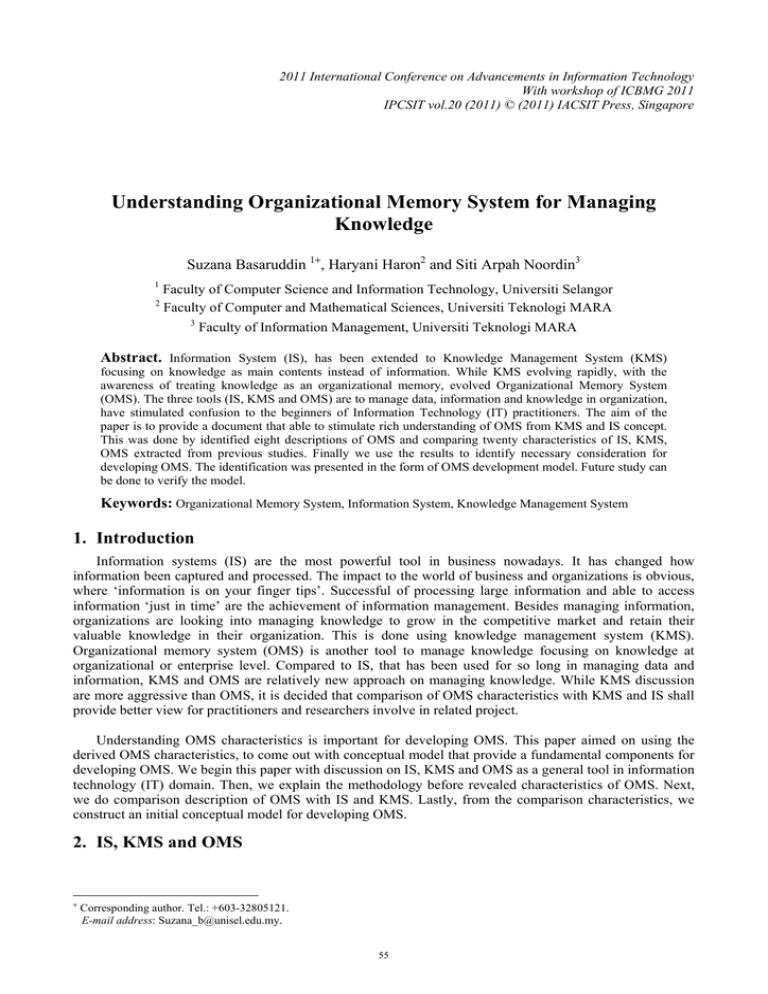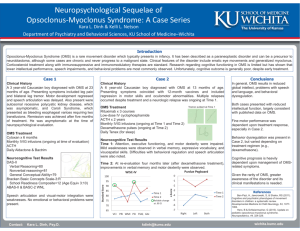Document 13134574
advertisement

2011 International Conference on Advancements in Information Technology With workshop of ICBMG 2011 IPCSIT vol.20 (2011) © (2011) IACSIT Press, Singapore Understanding Organizational Memory System for Managing Knowledge Suzana Basaruddin 1+, Haryani Haron2 and Siti Arpah Noordin3 1 2 Faculty of Computer Science and Information Technology, Universiti Selangor Faculty of Computer and Mathematical Sciences, Universiti Teknologi MARA 3 Faculty of Information Management, Universiti Teknologi MARA Abstract. Information System (IS), has been extended to Knowledge Management System (KMS) focusing on knowledge as main contents instead of information. While KMS evolving rapidly, with the awareness of treating knowledge as an organizational memory, evolved Organizational Memory System (OMS). The three tools (IS, KMS and OMS) are to manage data, information and knowledge in organization, have stimulated confusion to the beginners of Information Technology (IT) practitioners. The aim of the paper is to provide a document that able to stimulate rich understanding of OMS from KMS and IS concept. This was done by identified eight descriptions of OMS and comparing twenty characteristics of IS, KMS, OMS extracted from previous studies. Finally we use the results to identify necessary consideration for developing OMS. The identification was presented in the form of OMS development model. Future study can be done to verify the model. Keywords: Organizational Memory System, Information System, Knowledge Management System 1. Introduction Information systems (IS) are the most powerful tool in business nowadays. It has changed how information been captured and processed. The impact to the world of business and organizations is obvious, where ‘information is on your finger tips’. Successful of processing large information and able to access information ‘just in time’ are the achievement of information management. Besides managing information, organizations are looking into managing knowledge to grow in the competitive market and retain their valuable knowledge in their organization. This is done using knowledge management system (KMS). Organizational memory system (OMS) is another tool to manage knowledge focusing on knowledge at organizational or enterprise level. Compared to IS, that has been used for so long in managing data and information, KMS and OMS are relatively new approach on managing knowledge. While KMS discussion are more aggressive than OMS, it is decided that comparison of OMS characteristics with KMS and IS shall provide better view for practitioners and researchers involve in related project. Understanding OMS characteristics is important for developing OMS. This paper aimed on using the derived OMS characteristics, to come out with conceptual model that provide a fundamental components for developing OMS. We begin this paper with discussion on IS, KMS and OMS as a general tool in information technology (IT) domain. Then, we explain the methodology before revealed characteristics of OMS. Next, we do comparison description of OMS with IS and KMS. Lastly, from the comparison characteristics, we construct an initial conceptual model for developing OMS. 2. IS, KMS and OMS + Corresponding author. Tel.: +603-32805121. E-mail address: Suzana_b@unisel.edu.my. 55 Data, information and knowledge are important for organization to make decision making. Information system (IS) has been processing data and information with the use of digital technology since over past 50 years [1],[2],[3]. Data and information stored in computer system has been supporting small and large business processes. Members in organizations have been working with IS to maintain organizational effectiveness. While data and information of organizational operations is well managed through IS, organizational realize that managing information is not enough to grow the company. They figured out that with knowledge, they can come out with plan to tackle their focus customer, provide comprehensive knowledge about their product and develop strategy to achieve their vision and mission. Extended to that, they can retain their staffs’ knowledge that is losing when the staffs leave the organization. Knowledge gives more value to their organization. So focus on managing information remains, while interest on managing knowledge, increases [4]. Information management (IM) and knowledge management (KM) is two different approaches. [4] claimed that analyst and user are confused with IM and KM. This is also agreed by [5]. As an emerging research topic, KM has been inviting interest of researchers to debate on definitions and fundamental theories [6], [7], [8], [9], [10], [5]. Their study showed that there are wide discussions on KM but unfortunately very little consensus generated. Organization Memory System (OMS) is another tool on managing knowledge. Organizational memory (OM) covers knowledge in organizational context. It is intended for improving effectiveness in organization [11], [12]. OM is not representing all knowledge in the organization. It is remembering only pertinent knowledge to be reused in organizational activity. This concept is replicating human memory model which is not remembering all, but only necessary memory (past activity) for supporting current activity. 3. Methodology The paper attempted to propose a conceptual model on developing OMS in IHL to facilitate research learning. Researcher collected and compiled previous research articles related to OMS, and analyze the characteristics of OMS mentioned by previous researches. Finally the characteristics are listed and researcher investigated how the characteristics of OMS, different with KMS and IS. This clustering method is appropriate since there is no clear predefine classification characteristics found from the literature study. The result of the analysis is then used to construct initial OMS model. 4. Descriptions and Characteristics of OMS There are eight descriptions of OMS derived from the analysis of previous study of OMS; depicted in Table 1. Table 1. Descriptions of OMS No 1. Descriptions Collection of knowledge/ storage/location Author/s [13] [14] [15] [11] [12] [16] [17] [18] [19] [20] [21] [22] 2. For understand & reuse [15] [23][11] [12] [17] [24] [20] [25] [26] [27] [21] 3. Knowledge management process capturing, finding, disseminating [11] [28] [17] [18] [25] [21] [29] [26] [30] 4. Support decision making for continues enhancement/improvement [13] [15] [11] [23] [20] [31] [20] [29] 5. Set of practices been learnt [32] 6. Intelligent database [11] 7. Integrations of existing systems [24] [29] 8. Socially constructed, maintained and directed [21] [29] The most mentioned description of OMS mentioned has been pointed to accumulation of knowledge. These findings portray OMS as a place to continue collect and preserve organizational knowledge. Anyhow, accumulation of knowledge only is not enough for OMS. [24], [29] emphasized that the OMS should be the only place integrating and collecting the organizational knowledge. The second most noted description is about understanding knowledge and reuse the knowledge for current and future activities in the organization. 56 It is understood that OMS should able to stimulate the organizational learning that result in gaining new knowledge related to the organization. This knowledge should be interpreted and mapped to the current task in the organization. By doing this, the original knowledge is being referenced. This is how knowledge being reused. Another important description of OMS is about the process involved. The processes are capturing, finding and disseminating. Noticed that creation is not being included in the process. All researchers in row 3 of table 4 agreed on the process except [26] proposed creation being include in the OMS process. From detail analysis on the processes involved, it can be concluded that most researchers that refer to the process of OMS are referring to explicit knowledge. The rationale behind the fact is, explicit knowledge has widely been created digitally. So in the scope of explicit knowledge, the creation process most probably can be omitted. While this is true for explicit knowledge, in considering tacit knowledge for OMS, creation process may be required. The last most mentioned description about OMS is, OMS supporting decision making for continues enhancement and improvement in the organization. This attribute of OMS is derived from the reuse description of OMS mentioned before. The output of knowledge reuse suppose to support any decision in the organization and the outcome of applying the decision should improve organization. Besides the major four descriptions of OMS, some previous studies present different explanations of OMS. They are set of practices being learnt, intelligent database, integration of existing systems and socially constructed, maintained and directed. The last element (socially constructed, maintained and directed) are projecting the way OMS should be constructed and implemented; using workflow that is acceptable and dispensable by members in the organization. OMS & KMS can be conceived as special class of information system [12]. Digesting the description of OMS should able to provide organizations with overview of how OMS should be placed in their organization. But knowing OMS is not enough while organizations are more familiar and have more experience with IS and KMS. Due to that reason, researcher has studied the characteristics of all the three types of information/knowledge management system (i.e. IS, KMS and OMS). The end result is a set of contrast aiming on providing crystallized idea of OMS comparing to KMS and IS, as depicts in Table 2 and 3. Table 2 Understanding difference of IS, KMS and OMS No 1 2 3 Characteristic Objectivity Organization support Creating, Capturing, Organizing, Refining, Transfer knowledge Objective. Example: for clerk to enter data, officer to print report Objective. Example: KMS for technician to share technical information Support daily operation. Example: student registration system, purchasing system, room reservation system (Group level) Isolated development tools is possible ( stand alone) Support know-how to simplify learning. Example: Faculty KMS Support know how to simplify learning. Example: University OMS (Organizational level) Integrated development & implementation whole bundle of tools & system is used (not isolated single tool or system) Capturing, storing & subsequent accessing & replenishing organizational know-how (knowledge not created) Subjective. Example: OMS of research for institutional User requirement & technology Not supported Not applicable Necessary Not necessary Sustainability Depending on the Depending on participants Depending on participations System type 6 Usage of system 10 Add, edit, remove data Development consideration Knowledge reuse Expert directory for references 5 9 OMS (Unit/department level) Integrated development tool required for to support the function and group/community sharing KMS only Knowledge management & to search particular knowledge & learn from experience / know how User requirement, technology, knowledge available, culture Supported but not emphasize Tools & system 8 KMS Function 4 7 IS IS only Data maintenance & print report 57 Could integrate with IS or KMS Knowledge management & to search particular knowledge & learn from experience / know how & reuse knowledge for current solution/task User requirement, technology, knowledge available, culture, integration platform Supported and emphasized operation Table 3 Understanding similarities of IS, KMS and OMS No 1 Characteristic Management 2 Item 3 Reporting 4 5 6 7 8 9 10 End user Tacitness Top management support Workflow integration Learning Usage duration Human task IS KMS Managing information Only about data & values of information Daily, weekly, monthly and very detail Dedicated user (Farmer type) Explicit Not necessary Managing knowledge & information Include information on object related to information and knowledge (metadata) Specific to knowledge or expert available in the system (free format) Group or community (Farmer & explorer type) Tacit and/or explicit Necessary Managing knowledge & information OMS Not necessary Not supported Dedicated Passive Necessary Supported Not dedicated Active Necessary Supported Not dedicated Active Include information on object related to information and knowledge (metadata) Specific to knowledge or expert available in the system (free format) Organization/enterprise/institutional (Farmer and explorer type) Tacit and/or explicit Necessary Comparison characteristic has been regrouped into two, that are difference and similarities of the systems. Using Table 1, 2 and 3 as a guideline for developing OMS, researcher has identified five aspects related to technology need to be tackled. There should be considerations on technology aspect; i) how to adjust the OMS to IHL culture, ii) how OMS can facilitate learning in IHL, iii) how OMS can stimulate knowledge reuse in IHL, iv) how to integrate the OMS to current infrastructure and information/knowledge system in IHL and finally, v) how to use existing workflow of IHL in implementing OMS. Figure 1 envisioned the technology consideration for developing OMS. IHL research culture IHL workflow OMS development IHL integration IHL learning research IHL research knowledge reuse Fig. 1: OMS development model 5. Conclusions This paper presented a model of developing OMS. The model, derived from the identification of eight OMS descriptions, shall be the fundamental step of developing the OMS. The twenty comparison elements of OMS characteristics with KMS and IS was made to assist researcher from IS or KMS background in digesting OMS concept, as one system that have its own unique characteristics, besides has revealed some similarities as well. Extensive research through other method would provide alternative findings for validating and confirming the characteristics and model. 6. References [1] H. A, Simon. The future of information systems. Annals of Operations Research. 1997, 71: 3-14. [2] F, Burstein and C. W, Holsapple. New horizons at the core of information systems: decision support system advances. ISeB. 2007, 6: 109-115. [3] M, Davidsen and J, Krogstie. Information systems evolution over the last 15 years. CAiSE 2010, LNCS 6051, pp. 296-301. [4] E, Randeree. Knowledge management: securing the future. Journal of Knowledge Management. 2006, 10(4): 145156. 58 [5] G, Kebede. Knowledge management: An information science perspective. International Journal of Information Management. 2010, 30(5): 416-424. [6] B, Choi and H, Lee. An empirical investigation of km styles and their effect on corporate performance. Information and management. 2003, 40: 403-417. [7] J, Davis, E, Subramanian and A, Westerberg. Knowledge Management: Conceptual Foundations, Emerging Directions. Knowledge Management Organizational & Technological Dimensions. 2005, 3-20. [8] J, Mingers. Management knowledge and knowledge management: realism and forms of truth. Knowledge management research and practice. 2008, 6: 62-67. [9] P, Sharp. Make first steps – how a definition of K can help your organization. The Electronic Journal of Knowledge Management. 2008, 5(4): 487-496. [10] J. Aidemark. Knowledge Management Paradoxes. The Electronic Journal of Knowledge Management. 2009, 7(1): 1-10. [11] N, Wickramasinghe and D, von Lubitz. Knowledge-based Enterprise; theories & fundamental. Idea group publishing, 2007. [12] F. O. M, Lehner. Introduction and context of OM; How to manage expert sharing from organizational surprises to organizational knowledge. Imprint: Elsevier science ltd Ed: J H Erik Andriessen, B. Fahlbruch, 2004. [13] M, Vahedi and F. N. H. A, Irani. Info Tech (IT) for KM, in Procedia Comp Science 3. 2011, pp. 444-448. [14] N. A. A, Hamid and J, Salim. Exploring the role of Transactive Memory System (TMS) for Knowledge Transfer processes in Malaysia E-government IT Outsourcing, in International Conference of Information Retrieval & KM. 2010, pp. 303-309. [15] A, Sarirete, A, Chikh and E, Noble. Capitalizing K in communities of practice of e-learning: ontology-based community memory, M D Ltrras et al (Eds): WSKS 2009, CCIS 49, pp. 154-163. [16] J. B, Vasconcelos, C, Kimble and A, Rocha. Ontologies and the dynamics of organizational environments an example of a group memory system for the management of group competencies, in Proceedings of I-KNOW 2003. [17] J, Conklin. Designing organizational memory: preserving intellectual assets in a k-economy, http://www.cognexus.org/dom.pdf [18] F, Fandon, R, Dieng, O, Corby and A, Giboin. A Multi-agent system to support exploiting an XML-based CM, http://www.cs.cmu.edu/~fgandon/research/pakm2000/ [19] Cross, R. and Baird, L. Technology is not enough: Improving performance by building OM. Sloan Management Review, 2000, 69-78. [20] F, Lehner and R. K, Maier. How can OM theories contribute to OMS?. Information system frontiers. 2000, 2:3/4, 277-298 (2000) [21] M. S, Ackerman and C, Halverson. Considering an Organization’s Memory, in proceedings of ACM 1998 Conference on Computer Supported Cooperative work. [22] J, Euzenat. Corporate memory through cooperative creation of knowledge bases and hyper-documents, in Proceedings of 10th KAW, 1996, 36. [23] A, Leblanc and M. H, Abel. Using forum in an OL context, in ACM HT 2007. [24] R, Dieng, O, Corby, A, Gibboin and M, Ribiere. http://ksi.cpsc.ucalgary.ca /KAW/KAW98/dieng [25] A, Sengupta, D. C. Wilson and D. B, Leake. Constructing and Transforming CBR Implementations: Techniques for Corporate Memory Management, in Proceedings of the IJCAI-99 Workshop on Automating the Construction of Case based Reasoner. [26] K. A, Megill. The corporate Memory : Info mgmt in the electronic age. Bowker-Saur, 1997. [27] M, Divitini and C, Simone. Learning, memory & technology: some initial considerations, in SIGOIS Bulletin 1996, 17(3). [28] P, Demian and R, Fruchter. CoMem: Evaluating Interaction Methaphors for Knowledge Reuse from a CM Center for Integrated Facility Engineering (CIFE) Technical Report #158, 2004. [29] C, Wargitsch, T, Wewers and F, Theisinger. WorkBrain: Merging Organizational Memory and Workflow Management Systems, in Workshop of knowledge-based systems for knowledge management in enterprise at 21st Annual German Conference on AI, 1997, pp. 214-219. [30] E, Tulving and D. L, Schacter. What are the memory systems of 1994?. Massachusetts Institute of Technology, 1994. [31] R, Cross. and L, Baird. Technology is not enough: Improving performance by building OM. Sloan Management Review, 2000, 69-78. [32] J, Chosnek. Maintaining the corporate memory. Journal of Loss Prevention in the Process Industries. 2010, 23, 796-798. 59




